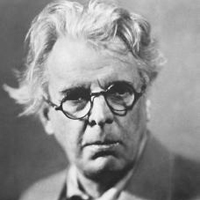The Songs of Wandering Aengus by William Butler Yeats: Summary and Critical Analysis
One early morning, in the twilight of dawn, Aengus goes into the forest, makes a fishing rod out of a stick of haze, a thread and using a berry as bait, catches a little silver trout. As he blows on the fire to cook the fish, the fish is transformed into a “glimmering girl” with apple blossom in her hair.

William B. Yeats (1865-1939)
She fades into the brightening light after calling him by name. Tough old and exhausted in his search for her, Aengus still dreams of finding her and kissing her and making love to her. Indeed he is determined to find her, if he has to search till eternity, and then he will pluck the silver apples of the moon and the golden apples of the sun. This poem is about Yeats's passion for Maud Gonne. However, the poem itself speaks poet's passion for Irish folktales and legends.
An interesting interpretation of the poem is to consider it to have been constructed from light itself. A “fire” in his head drives Aengus to the hazel wood. The ‘fire’ in the mind is the burning passion or fire of love. ‘Fire aflame’ in the second line of the second stanza is the fire of love which the poet wants to burn in the heart of the woman. He goes fishing in the twilight of dawn when “white moths” fly and “moth-like stars” flicker out, the time, as Yeats often pointed out, when miracles are most likely to happen. All the terms-“silver”, “aflame”, “glimmering”, “brightening”-derive from the light. The imagery in the final part of the poem combines light and apple blossoms, only now the blossoms have grown into shining fruit which gives light to all things- the silver apples of the moon, and the golden apples of the sun. In Yeats’s mythological imagination, when the mystical brotherhood of the sun and moon combine with natural things, man is freed from the web of the natural world and its laws.
The style of the poem is simple and well illustrates Yeats’s early poetical manner. It draws strength from deliberate repetitions and strong verbs, such as “peeled”, “hooked”, “dropped”. The poem has some exquisite imagery conjured up through words such as “white moths on the wing”, “moth-like stars flickering out”, “a little silver trout”, “a glimmering girl with apple blossom in her hair”. As for symbolism contained in the image of the silver and golden apples, it is derived from Kabalistic (or occult) lore in which the Tree of Life is an apple tree with the sun and the moon as its fruits. The symbolism of the last lines relates to the “glimmering girl” with apple blossoms in her hair-who is an image of Maud Gonne. In this later poetry, Yeats was to use this kind of complex relationship between symbols with increasing richness of meaning and suggestion.
In “The Song of Wandering Aengus”, the sun and the moon play upon basic meanings, the masculine and the feminine, assigned to them. Aengus catches a silver (recalling moonlight) trout and, significantly it turns into a glimmering girl. The moon is equivalent to the feminine. Aengus says that he has not given up his chase through “hollow lands and hilly lands” and that he will continue until he rediscovers her. The apples of the sun and the moon are thus associated with an indolently pleasant sexual relation.
In conclusion we may say that “The Song of Wandering Aengus” expresses a quest for the impossible and unattainable. Legend is transformed by Yeats into a personal myth. Aengus’ unsatisfied love is symbolical, and shows the wide gap between reality and fancy.
Cite this Page!
Sharma, K.N. "The Songs of Wandering Aengus by William Butler Yeats: Summary and Critical Analysis." BachelorandMaster, 23 Nov. 2013, bachelorandmaster.com/britishandamericanpoetry/songs-of-wandering-aengus.html.
Related Topics
The Scholars: Critical Analysis
Sailing to Byzantium: Analysis
The Theme of Immortality in Byzantium Poems
A Prayer for My Daughter: Analysis
Among School Children: Analysis
Crazy Jane Talks with the Bishop
The Lamentation of the Old Pensioner
He Wishes for the Clothes of Heaven
An Irish Airman Foresees his Death
When You Are Old: Summary and Analysis
William Butler Yeats as a Symbolist
Truth of Human Life in Yeats's Poetry
Yeats and the Romantic Tradition
The Salient Features of Yeats's Poetry
Biography of William Butler Yeats
 |
bachelorandmaster.com |